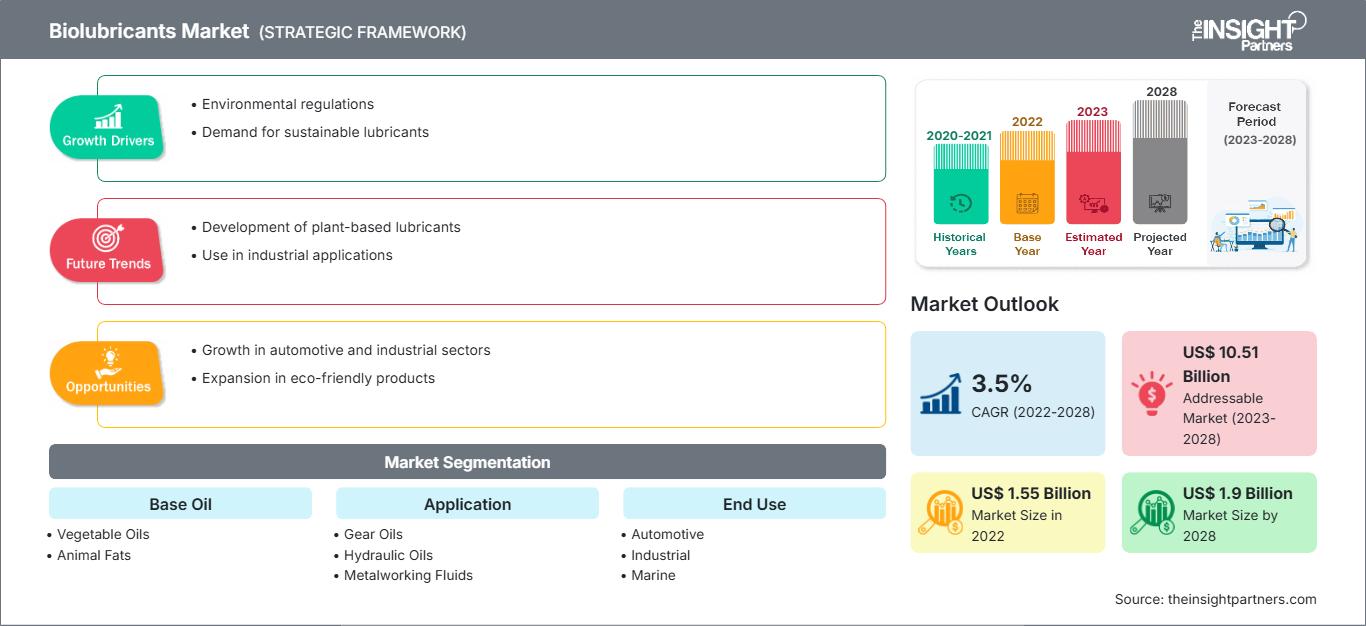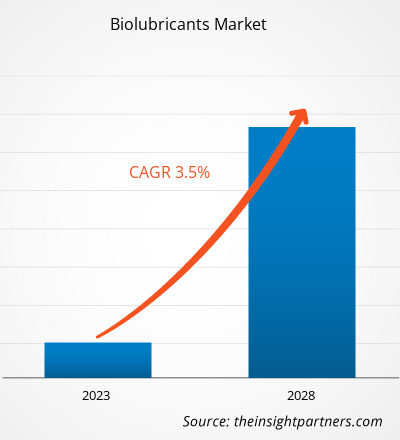Der Markt für Bioschmierstoffe soll von 1.551,15 Millionen US-Dollar im Jahr 2022 auf 1.902,41 Millionen US-Dollar im Jahr 2028 wachsen; für den Zeitraum von 2022 bis 2028 wird eine durchschnittliche jährliche Wachstumsrate (CAGR) von 3,5 % erwartet.
Bioschmierstoffe werden aus Ölen hergestellt, die aus Pflanzen und anderen nachwachsenden Rohstoffen, einschließlich tierischer Produkte, gewonnen werden. Bioschmierstoffe sind biologisch abbaubar und ungiftig für Mensch und Wasser. Die biologische Abbaubarkeit von Bioschmierstoffen spielt eine entscheidende Rolle bei Anwendungen mit hohem Risiko des Austretens in die Umwelt. Darüber hinaus haben Bioschmierstoffe höhere Flammpunkte, eine konstante Viskosität und weniger Ölnebel-/Dampfemissionen und bieten so mehr Sicherheit. Bioschmierstoffe produzieren außerdem weniger Emissionen und haften besser auf Metalloberflächen. Sie werden in verschiedenen Anwendungen eingesetzt, darunter Motoren, Getriebe, Hydraulik, Kettensägen, Schmierfette und 2-Takt-Schnellbootmotoren. Bioschmierstoffe werden in zahlreichen Endverbrauchsbranchen eingesetzt, beispielsweise in der Automobil- und Schifffahrt, in der Land- und Forstwirtschaft, im Bergbau, im Baugewerbe, in der Kraftübertragung, in der Lebensmittel- und Pharmaindustrie.
Das Wachstum des Bioschmierstoffmarktes ist auf die steigende Nachfrage nach Bioschmierstoffen aus verschiedenen Endverbrauchsbranchen zurückzuführen. Diese Nachfrage ist auf ein gestiegenes Umweltbewusstsein, strenge Umweltgesetze, die die Verwendung umweltfreundlicher Schmierstoffe vorschreiben, und die hohen Entsorgungskosten der vorhandenen, nicht abbaubaren Schmierstoffe zurückzuführen. In vielen Ländern gibt es Vorschriften, die die Verwendung mineralölbasierter Schmierstoffe auf Binnenwasserstraßen verbieten. Solche Vorschriften treiben die Nachfrage nach Bioschmierstoffen für verschiedene Anwendungen an. Da Bioschmierstoffe sauber und ungiftig sind, ist ihr Einsatz in hochsensiblen Anwendungen wie der Forst- und Schifffahrt in einigen Ländern weltweit vorgeschrieben. In der Schifffahrt werden Bioschmierstoffe in verschiedenen Bereichen und Prozessen von Containern, Frachtflotten, Öltankern und anderen Schiffen zur Schmierung eingesetzt. Zu den marinen Bioschmierstoffen zählen Motoröle, Hydrauliköle, Kompressorenöle, Gleitbahnöle, Getriebeöle, Wärmeträgeröle, Fette, Turbinenöle und weitere. Das Wachstum des globalen Seehandels hat die Nachfrage nach Bioschmierstoffen aufgrund ihrer hohen Effizienz und geringen Emissionswerte zusätzlich angekurbelt. Der verstärkte Einsatz von Bioschmierstoffen in der Schifffahrtsindustrie bietet daher im Prognosezeitraum lukrative Chancen für den Bioschmierstoffmarkt.
Passen Sie diesen Bericht Ihren Anforderungen an
Sie erhalten kostenlos Anpassungen an jedem Bericht, einschließlich Teilen dieses Berichts oder einer Analyse auf Länderebene, eines Excel-Datenpakets sowie tolle Angebote und Rabatte für Start-ups und Universitäten.
Markt für Bioschmierstoffe: Strategische Einblicke

-
Holen Sie sich die wichtigsten Markttrends aus diesem Bericht.Dieses KOSTENLOSE Beispiel umfasst Datenanalysen, die von Markttrends bis hin zu Schätzungen und Prognosen reichen.
Markteinblicke
Steigende Nachfrage aus der Automobilindustrie treibt Wachstum des Bioschmierstoffmarktes voran
Motorenöle, Getriebeflüssigkeiten, Brems- und Hydraulikflüssigkeiten sowie andere Fahrzeugöle werden in der Automobil- und Transportindustrie verwendet. Bioschmierstoffe dienen als Gleit- und Wärmeabsorptionsmittel und sorgen für einen reibungslosen und zuverlässigen Betrieb. Sie reduzieren das Risiko häufiger Ausfälle und tragen so zur Lebensdauer des Fahrzeugs bei. Fahrzeugschmierstoffe werden eingesetzt, um Reibung zu reduzieren und die beim Kontakt zweier Oberflächen entstehende Wärme zu regulieren. Biobasierte Motoröle zeichnen sich zudem durch eine höhere inhärente biologische Abbaubarkeit, geringe Toxizität für Wasserorganismen und eine sehr geringe Bioakkumulation aus. Der Ersatz von kohlenwasserstoffbasierten Ölen durch biologisch abbaubare Produkte ist eine Möglichkeit, die negativen Auswirkungen von Schmierstoffen auf das Ökosystem zu reduzieren. Mit dem zunehmenden regulatorischen Druck zur Verbesserung der Kraftstoffeffizienz von Fahrzeugen und zur Reduzierung der Treibhausgasemissionen hat es eine bemerkenswerte Entwicklung bei Schmierstoffformulierungen gegeben. Diese Faktoren steigern die Nachfrage nach Bioschmierstoffen in der Automobilindustrie.
Einblicke in Grundöle
Basierend auf dem Grundöl ist der Markt für Bioschmierstoffe in Pflanzenöle, tierische Fette und andere segmentiert. Das Segment Pflanzenöle hatte 2022 den größten Marktanteil. Pflanzenöle sind aufgrund bestimmter inhärenter Eigenschaften, darunter hohe Viskosität, hoher Siedebereich und biologische Abbaubarkeit, bevorzugte Alternativen zu Mineralölen für Schmierstoffgrundstoffe. Fettsäuren im Öl können chemisch modifiziert werden, um hochmolekulare Ester zu bilden, die herkömmliche Schmierstoffe auf Mineralölbasis ersetzen können. Diese Faktoren werden voraussichtlich das Marktwachstum für das Segment Pflanzenöle vorantreiben.
EmeryOleochemicals LLC, Fuchs Petrolub SE, Carl Bechem GmbH, PANOLIN AG, Renewable Lubricants Inc, TotalEnergies SE, Shell Plc, RSC Bio Solutions LLC, Crevier Group Inc und Kluber Lubrication GmbH & Co KG gehören zu den wichtigsten Akteuren auf dem Markt für Bioschmierstoffe. Die führenden Akteure verfolgen Strategien wie Fusionen und Übernahmen sowie Produkteinführungen, um ihre geografische Präsenz und Kundenbasis zu erweitern.
Bioschmierstoffe
Regionale Einblicke in den Markt für BioschmierstoffeDie Analysten von The Insight Partners haben die regionalen Trends und Faktoren, die den Markt für Bioschmierstoffe im Prognosezeitraum beeinflussen, ausführlich erläutert. In diesem Abschnitt werden auch die Marktsegmente und die geografische Lage von Bioschmierstoffen in Nordamerika, Europa, dem asiatisch-pazifischen Raum, dem Nahen Osten und Afrika sowie Süd- und Mittelamerika erörtert.
Umfang des Marktberichts zu Bioschmierstoffen
| Berichtsattribut | Einzelheiten |
|---|---|
| Marktgröße in 2022 | US$ 1.55 Billion |
| Marktgröße nach 2028 | US$ 1.9 Billion |
| Globale CAGR (2022 - 2028) | 3.5% |
| Historische Daten | 2020-2021 |
| Prognosezeitraum | 2023-2028 |
| Abgedeckte Segmente |
By Basisöl
|
| Abgedeckte Regionen und Länder |
Nordamerika
|
| Marktführer und wichtige Unternehmensprofile |
|
Dichte der Marktteilnehmer für Bioschmierstoffe: Verständnis ihrer Auswirkungen auf die Geschäftsdynamik
Der Markt für Bioschmierstoffe wächst rasant. Die steigende Nachfrage der Endverbraucher ist auf Faktoren wie veränderte Verbraucherpräferenzen, technologische Fortschritte und ein stärkeres Bewusstsein für die Produktvorteile zurückzuführen. Mit der steigenden Nachfrage erweitern Unternehmen ihr Angebot, entwickeln Innovationen, um den Bedürfnissen der Verbraucher gerecht zu werden, und nutzen neue Trends, was das Marktwachstum weiter ankurbelt.

- Holen Sie sich die Markt für Bioschmierstoffe Übersicht der wichtigsten Akteure
Berichts-Spotlights
- Progressive Trends in der Bioschmierstoffbranche unterstützen Akteure bei der Entwicklung effektiver Langzeitstrategien
- Geschäftswachstumsstrategien von Unternehmen zur Sicherung des Wachstums in entwickelten und sich entwickelnden Märkten
- Quantitative Analyse des globalen Bioschmierstoffmarktes von 2020 bis 2028
- Schätzung der Nachfrage nach Bioschmierstoffen in verschiedenen Branchen
- Porters Fünf-Kräfte-Analyse zur Veranschaulichung der Wirksamkeit von Käufern und Lieferanten in der Bioschmierstoffbranche
- Jüngste Entwicklungen zum Verständnis des Wettbewerbsmarktszenarios und der Nachfrage nach Bioschmierstoffen
- Markttrends und -aussichten sowie Faktoren, die das Wachstum des Bioschmierstoffmarktes bestimmen
- Aufschlussreiche Strategien, die das kommerzielle Interesse am Marktwachstum untermauern und den Entscheidungsprozess unterstützen
- Marktgröße für Bioschmierstoffe an verschiedenen Marktknotenpunkten
- Detaillierte Übersicht und Segmentierung des Marktes sowie seiner Branche Dynamik
- Marktgröße für Bioschmierstoffe in verschiedenen Regionen mit vielversprechenden Wachstumschancen
Die „Marktprognose für Bioschmierstoffe bis 2028“ ist eine spezialisierte und eingehende Studie der Chemie- und Werkstoffindustrie mit Schwerpunkt auf der Trendanalyse des Bioschmierstoffmarktes. Der Bericht soll einen Marktüberblick mit detaillierter Segmentierung geben. Der Markt für Bioschmierstoffe ist nach Grundöl, Anwendung, Endverbrauch und Geografie segmentiert. Basierend auf dem Grundöl ist der Markt in Pflanzenöle, tierische Fette und Sonstiges unterteilt. Basierend auf der Anwendung ist der Markt in Getriebeöle, Hydrauliköle, Metallbearbeitungsflüssigkeiten, Schmierfette und Sonstiges unterteilt. Nach Endverbrauch ist der Markt für Bioschmierstoffe in Automobil, Industrie, Schifffahrt, Land- und Forstwirtschaft und Sonstiges unterteilt. Der Markt ist in fünf Hauptregionen segmentiert: Nordamerika, Europa, Asien-Pazifik, Naher Osten und Afrika sowie Süd- und Mittelamerika. Im Jahr 2022 dominierte Europa den Markt für Bioschmierstoffe. Der asiatisch-pazifische Raum wird im Prognosezeitraum voraussichtlich die höchste jährliche Wachstumsrate (CAGR) verzeichnen. Faktoren wie wachsende Umweltbedenken und steigende Rohölpreise treiben die Nachfrage nach Bioschmierstoffen in Europa an. Die Nachfrage nach Bioschmierstoffen im asiatisch-pazifischen Raum ist direkt proportional zur Industrialisierung und Fahrzeugproduktion in der Region. Wachsende regionale Bauaktivitäten sowie der Industrie- und Automobilsektor beschleunigen das Marktwachstum.
- Historische Analyse (2 Jahre), Basisjahr, Prognose (7 Jahre) mit CAGR
- PEST- und SWOT-Analyse
- Marktgröße Wert/Volumen – Global, Regional, Land
- Branchen- und Wettbewerbslandschaft
- Excel-Datensatz
Aktuelle Berichte
Verwandte Berichte
Erfahrungsberichte
Grund zum Kauf
- Fundierte Entscheidungsfindung
- Marktdynamik verstehen
- Wettbewerbsanalyse
- Kundeneinblicke
- Marktprognosen
- Risikominimierung
- Strategische Planung
- Investitionsbegründung
- Identifizierung neuer Märkte
- Verbesserung von Marketingstrategien
- Steigerung der Betriebseffizienz
- Anpassung an regulatorische Trends






















 Kostenlose Probe anfordern für - Markt für Bioschmierstoffe
Kostenlose Probe anfordern für - Markt für Bioschmierstoffe